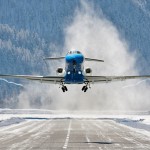Every winter snow and ice affect private flights and scheduled airlines alike. (You might remember during the snow last December that Heathrow’s planes were all grounded as Heathrow ran out of de-icing fluid). It is a legal requirement for all aircraft (whether private or scheduled) to be de-iced before take-off.
The de-icing process is similar to de-icing your car windscreen – although on an industrial scale! The aircraft is hosed down with de-icing fluid (which is coloured orange so you can see where the fluid has been applied). If the weather is particularly cold, or it is snowing during the de-icing process, it might have to be done several times before take-off.
Private jet charterers are liable for the costs of de-icing, unless they have taken out a de-icing waiver at the time of their booking. Charterers may be able to avoid de-icing if the aircraft is kept in a hangar, or is parked in a heated hangar until just before take-off. Here’s PrivateFly’s de-icing waiver
Here’s my top 10 tips for de-icing:
1. Ask your private jet supplier the night before your flight if de-icing is expected to be required. This will encourage them to avoid de-icing if possible. See how to avoid paying de-icing costs.
2. Use a heated hangar to keep your private jet protected from the weather and melt any ice that has formed.
3. Encourage your crew to remove layers of snow with a brush from the wings before the aircraft is de-iced. This will reduce the amount of de-icing fluid required. This manual procedure is only possible on small aircraft. On large private jets it is not safe to remove snow from the wings.
4. Keep your private jet crew informed of when you will be arriving at the FBO (private jet terminal) This will allow the de-icing to be timed just before your arrival and prevent it being required twice.
5. Ask to be on-board your private jet when it is de-iced. This will allow your aircraft to depart immediately after the anti-icing fluid is applied. A further de-ice may be required if your departure is delayed.
6. Never argue against a de-ice. Your private jet Captain is making a safety decision and should not be influenced by financial or time considerations.
7. Ask your crew how much quantity of de-icing fluid is expected to be used before the de-ice starts. This will encourage the crew to remove excess snow from the airframe with a brush to reduce the amount of fluid required. In larger aircraft this will not be possible.
8. If you have a choice of airports, ask for the price of de-icing fluid at each FBO (Private Jet Terminal). Depart from the private jet airport that offers the lowest price of de-icing fluid. Often the de-ice is more expensive than the landing and handling fees.
9. If possible avoid flying early in the morning. Often the sun will melt any small layers of ice on a private jet.
10. Buy a de-icing waiver from PrivateFly before your private jet flight call us on +44 (0) 1747 642 777 or email enquiries@privatefly.com
Related content

What happens after you book a flight with PrivateFly?

Can a private jet fly in the snow?



